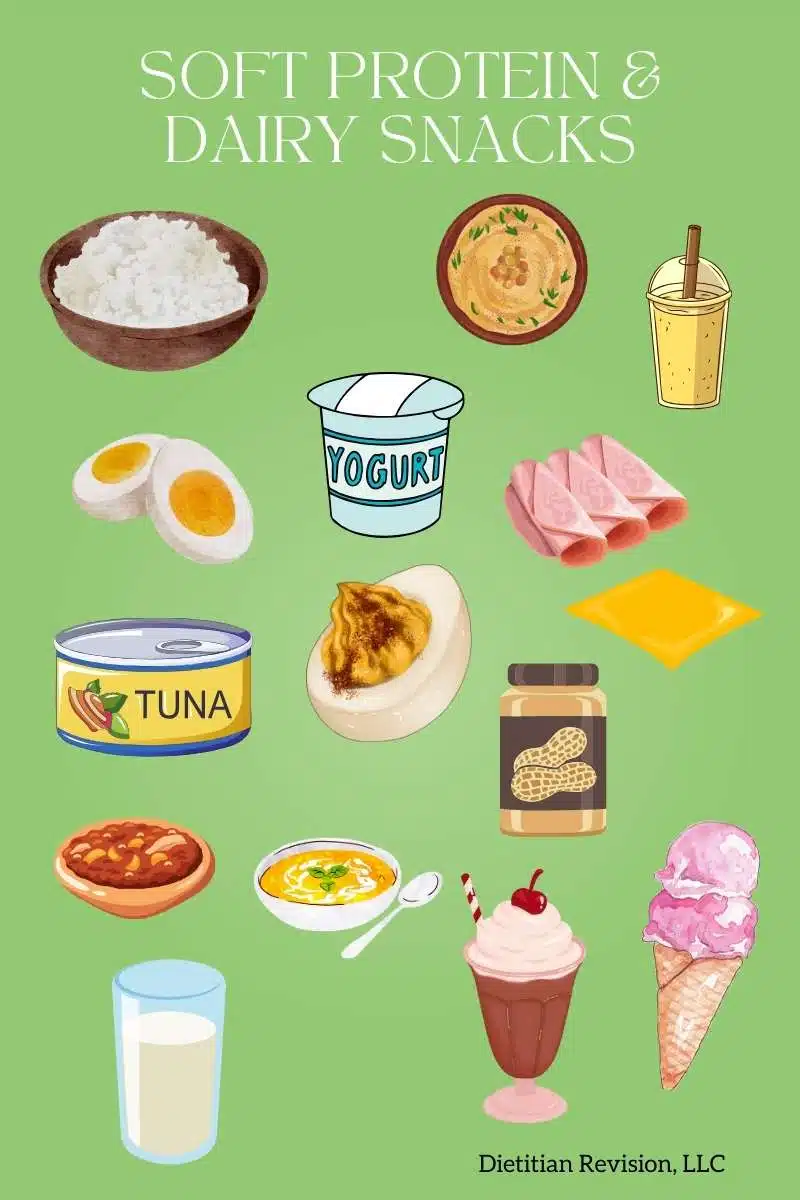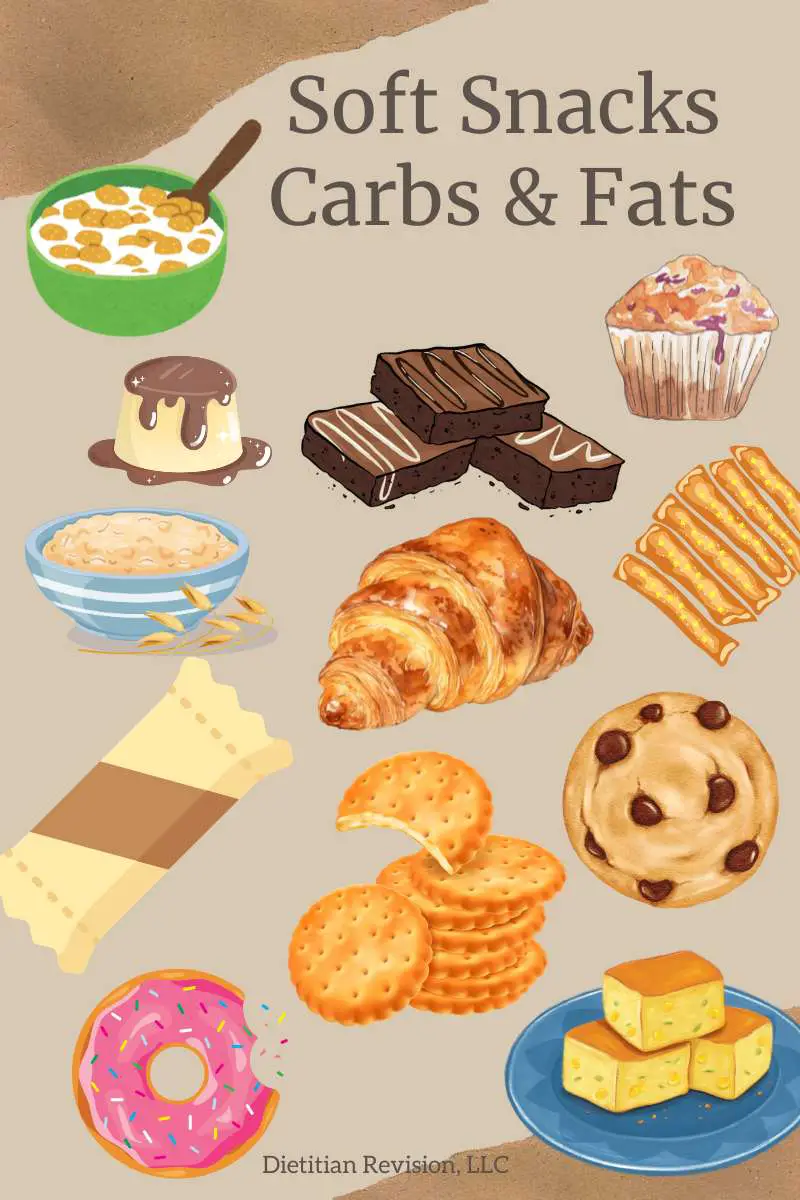As we age, our nutritional needs change, and sometimes chewing becomes a challenge. However, maintaining proper nutrition remains crucial.
Let’s explore soft snack options tailored to the needs of the elderly, curated by a geriatric registered dietitian.
Who needs soft snacks?
Poor oral status and dentition can occur in aging adults. This may impact chewing ability. Soft foods are easier to chew when teeth are minimal to none.
Some older adults may even have difficulty swallowing, from various conditions such as dementia, stroke, or Parkinson’s.
Softer foods can be easier to move around the mouth to chew, and safer to swallow. Some may fatigue easily when eating and snacks can help add more nutrition throughout the day.
Majority of the elderly can benefit from snacking due to the increased risk for under-nutrition.
Soft Snack Ideas
Here are 39 soft snacks ideas to serve to the elderly:
- Applesauce
- Yogurt
- Cottage cheese
- Smoothie
- Protein shake
- Boiled egg
- Egg salad
- Pudding
- Hummus
- Avocado
- Canned peaches
- Canned pears
- Muffin
- Tuna salad
- Gelatin
- Popsicles
- Oatmeal
- Chicken salad
- Croissant
- Soft cereal bars
- Luncheon meat & cheese roll up
- Brownie
- Soft cookie
- Banana
- Fig bar
- Deviled eggs
- Refried beans on soft tortillas
- Nut butter on soft crackers
- Baked apples
- Plantains
- Soft biscuit with butter and/or jelly
- Cornbread
- Donut
- Cereal
- French toast sticks with syrup
- Soup
- Ripe melon
- Ice cream
- Milkshakes
Proteins & Dairy
Many older adult’s meat intake decreases with age due to chewing difficulty and taste changes. Adding protein snacks throughout the day can help meet nutrient needs.
- Yogurt
- Cottage cheese
- Protein shake
- Boiled egg
- Egg salad
- Hummus
- Tuna salad
- Chicken salad
- Lunch meat & cheese
- Deviled eggs
- Refried beans on soft tortillas
- Nut butters on soft crackers or bread
- Soup
- Ice cream
- Milkshake
- Add a glass of milk to any snacks

Fruits
Fruits tend to be well accepted amongst the elderly due to their sweet taste. There are many fruit options that are ready-to-eat, making them easily available for snacking.
- Applesauce
- Smoothie
- Avocado
- Canned peaches
- Canned pears
- Fruited gelatin
- Frozen fruit bars
- Banana
- Baked apples
- Plantains
- Ripe melon

Carbohydrates & Fats
Finding ways to increase calorie intake can be tricky. Sweeter items may be better accepted due to diminishing taste.
These are also higher calorie items with less volume. Fat is necessary to vitamin absorption and adds extra calories. Carbohydrates are the body’s, especially the brain, main source of energy
Adding nut butters, butter, and dipping sauces to snacks can increase the caloric density of snacks without adding overwhelming volume.
- Pudding
- Muffins
- Oatmeal
- Croissants (or other soft breads)
- Soft cereal bar
- Brownie
- Soft cookie
- Fig bar
- Soft crackers with nut butter
- Soft biscuit with butter and/or jelly
- Cornbread
- Donut
- Cereal with milk
- French toast sticks with syrup

Benefits of Snacking
The geriatric population is at increased risk for undernutrition, which can contribute to many complications and poor quality of life.
Poor meal intake can be common, especially for those with dementia and other progressive diseases.
Snacks are a great way to promote smaller, more frequent opportunities for nutrition throughout the day. They make it easier for nutritional needs to be met.
Increasing nutritional intake can help preserve lean body mass, which is important for maintaining mobility and preventing falls.
Snacks can add more fiber and fluids to the diet and even improve mood, by just tasting good. Food is also a great way to increase social interaction.
Nutritional Considerations for Snacks
When choosing snacks, acceptance should be the first priority. If they aren’t going to eat them, then they won’t do any good.
If intake of certain food groups are low at meals, then try incorporating these into snack times. If meat consumption is low, offer protein containing snacks.
Providing snacks with carbohydrates and protein is a good combination for people with diabetes. This can help keep blood sugar stable.
Change up the snack rotations to avoid burnout. Keep snacks easily accessible to promote intake. Ready to eat options may be easier since no prep work is needed.
Practical Takeaways
Many elderly folks have factors impacting their dentition and overall oral status. Chewing and/or swallowing may be more difficult.
Soft snacks can add necessary nutrients throughout the day to ward off malnutrition and preserve muscle mass.
Use the lists above to rotate soft snacks into your loved ones day. Keep ready to eat options on hand and visible for easy access.



